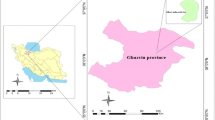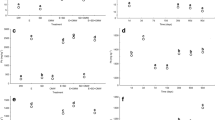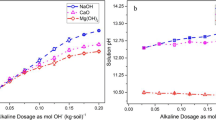Abstract
The present study aims to transform a treated soil (TS) into a more desirable resource by modifying physico-chemical properties via amendments while reducing toxic metals’ mobility and oral bioaccessibility. A hydrocarbon-contaminated soil submitted to treatment (TS) but still containing elevated concentrations of Cu, Ni, Pb, and Zn has been amended with compost, sand, and Al2(SO4)3 to render it usable for horticulture. Characterization and sequential extraction were performed for TS and four amended mixtures (AM1-4). P and K availability and metal bioaccessibility were investigated in TS and AM2. Amendment improved soil properties for all mixtures and yielded a usable product (AM2 20 % TS, 49 % compost, 30 % sand, 1 % Al2(SO4)3) satisfying regulatory requirements except for Pb content. In particular, AM2 had improved organic matter (OM) and cation exchange capacity (CEC), highly increased P and K availability, and reduced total metal concentrations. Furthermore, amendment decreased metal mobile fraction likely to be plant-available (in mg kg−1, assumed as soluble/exchangeable + carbonates fractions). For AM2, estimated Pb bioavailability decreased from 1.50 × 103 mg kg−1 (TS) to 238 mg kg−1 (52.4 % (TS) to 34.2 %). Bioaccessible concentrations of Cu, Ni, and Zn (mg kg−1) were lower in AM2 than in TS, but there was no significant decrease for Pb. The results suggest that amendment improved soil by modifying its chemistry, resulting in lower metal mobile fraction (in %, for Cu and Zn) and bioaccessibility (in %, for Cu only). Amending soils having residual metal contamination can be an efficient valorization method, indicating potential for reducing treatment cost and environmental burden by rendering disposal/additional treatment unnecessary. Further studies including plant bioavailability are recommended to confirm results.

Similar content being viewed by others
References
Angelova, V. R., Ivanova, R. V., Todorov, J. M., & Ivanov, K. I. (2010). Lead, cadmium, zinc, and copper bioavailability in the soil-plant-animal system in a polluted area. Scientific World Journal, 10, 273–285.
ASTM International. (2013). Standard test method for pH of soils–method D4972-13. West Conshohocken: ASTM International.
ATSDR (2005a) Toxicological profile for zinc. Toxic substances portal. http://www.atsdr.cdc.gov/toxprofiles/tp.asp?id=302&tid=54. Accessed 9 October 2014.
ATSDR (2005b) Toxicological profile for nickel. Toxic substances portal. http://www.atsdr.cdc.gov/toxprofiles/tp.asp?id=245&tid=44. Accessed: 9 October 2014.
ATSDR (2007) Toxicological profile for lead. ATSDR toxic substances portal. http://www.atsdr.cdc.gov/toxprofiles/tp.asp?id=96&tid=22. Accessed 9 October 2014.
ATSDR (Agency for Toxic Substances and Disease Registry) (2004) Toxicological profile for copper. Toxic substances portal. http://www.atsdr.cdc.gov/toxprofiles/tp.asp?id=206&tid=37. Accessed 9 October 2014.
Balasoiu, C. F., Zagury, G. J., & Deschênes, L. (2001). Partitioning and speciation of chromium, copper, and arsenic in CCA-contaminated soils: influence of soil composition. The Science of the Total Environment, 280, 239–255.
BNQ (Bureau de Normalisation du Québec). (2001). Amenagement paysager à l’aide de végétaux. QC, Canada: Sainte-Foy.
Brown, S., Chaney, R., Hallfrisch, J., Ryan, J. A., & Berti, W. R. (2004). In situ soil treatments to reduce the phyto- and bioavailability of lead, zinc, and cadmium. Journal of Environmental Quality, 531, 522–531.
Castaldi, P., Santona, L., & Melis, P. (2005). Heavy metal immobilization by chemical amendments in a polluted soil and influence on white lupin growth. Chemosphere, 60, 365–371.
CEAEQ (2014) Détermination des métaux : méthode par spectrométrie de masse à source ionisante au plasma d’argon. Quebec, QC, Canada.
Chapman, H. D. (1965). Methods of soil analysis. Madison: American Society of Agronomy Inc.
Clesceri, L. S., Greenberg, A. E., & Eaton, A. D. (1999). Standard methods for the examination of water and wastewater (20th ed.). Washington, DC: American Public Health Association.
Cooperband, L. (2002). Building soil organic matter with organic amendments. Madison: Center for Integrated Agricultural Systems.
CPVQ (Conseil des Productions Végétales du Québec) (1997) Méthodes d’analyse des sols, des fumiers et des tissus végétaux. Quebec, QC, Canada.
CEAEQ (Centre d’Expertise en Analyse Environnementale du Québec) (2013) Recherche des salmonelles : méthode présence/absence. Quebec, QC, Canada.
Evans, L. J. (1989). Chemistry of metal retention. Environmental Science and Technology, 23, 1046–1056.
Farrell, M., & Jones, D. L. (2010). Use of composts in the remediation of heavy metal contaminated soil. Journal of Hazardous Materials, 175, 575–582.
Farrell, M., Perkins, W. T., Hobbs, P. J., Griffith, G. W., & Jones, D. L. (2010). Migration of heavy metals in soil as influenced by compost amendments. Environmental Pollution, 158, 55–64.
Girouard, E., & Zagury, G. J. (2009). Arsenic bioaccessibility in CCA-contaminated soils: influence of soil properties, arsenic fractionation, and particle-size fraction. The Science of the Total Environment, 407, 2576–2585.
Ho, M. D., & Evans, G. J. (1997). Operational speciation of cadmium, copper, lead and zinc in the NIST Standard Reference Materials 2710 and 2711 (Montana Soil) by the BCR sequential extraction procedure and flame atomic absorption spectrometry. Analytical Communications, 34, 363–364.
Lanphear, B. P., Dietrich, K., Auinger, P., & Cox, C. (2000). Cognitive deficits associated with blood lead concentrations <10 μg/dL in US children and adolescents. Public Health Reports, 115, 521–529.
Ljung, K., Oomen, A., Duits, M., Selinus, O., & Berglund, M. (2007). Bioaccessibility of metals in urban playground soils. Journal Environment Science Health Part A, 42, 1241–1250.
Madejón, E., de Mora, A. P., Felipe, E., Burgos, P., & Cabrera, F. (2006). Soil amendments reduce trace element solubility in a contaminated soil and allow regrowth of natural vegetation. Environmental Pollution, 139, 40–52.
McLean JE, Bledsoe BE (1992) Behavior of metals in soils. United States Environmental Protection Agency. Washington, DC.
MDDEP (Ministère du Développement Durable, de l' Environnement et des Parcs) (1998) Politique de protection des sols et de réhabilitation des terrains contaminés–Annexe 2 : Les critères génériques pour les sols et pour les eaux souterraines. http://www.mddelcc.gouv.qc.ca/sol/terrains/politique/annexe_2.htm. Accessed 9 October 2014.
MDDEP (2012) Guide sur le recyclage des matières résiduelles fertilisantes. Quebec, QC, Canada.
Miller, G., Begonia, G., Begonia, M., & Ntoni, J. (2008). Bioavailability and uptake of lead by coffeeweed (Sesbania exaltata Raf.). International Journal Environmental Research Public Health, 5, 436–440.
Mulligan, C. N., Yong, R. N., & Gibbs, B. F. (2001). Remediation technologies for metal-contaminated soils and groundwater: an evaluation. Engineering Geology, 60, 193–207.
Pérez-de-Mora, A., Burgos, P., Cabrera, F., & Madejón, E. (2007). “In situ” amendments and revegetation reduce trace element leaching in a contaminated soil. Water, Air, and Soil Pollution, 185, 209–222.
Pollmann, O., Meyer, S., Blumenstein, O., & Rensburg, L. (2010). Mine tailings: waste or valuable resource? Waste and Biomass Valorization, 1, 451–459.
Pouschat, P., & Zagury, G. J. (2006). In vitro gastrointestinal bioavailability of arsenic in soils collected near CCA-treated utility poles. Environmental Science and Technology, 40, 4317–4323.
Pouschat, P., & Zagury, G. J. (2008). Bioaccessibility of chromium and copper in soils near CCA-treated wood poles. Practice Period Hazardous, Toxic, Radioact Waste Management, 12, 216–223.
Recyc-Quebec (2013) Bilan de la Gestion des Matières Résiduelles au Québec 2010–2011. Québec, QC, Canada.
Rodriguez, R. R., Basta, N. T., Casteel, S. W., & Pace, L. W. (1999). An in vitro gastrointestinal method to estimate bioavailable arsenic in contaminated soils and solid media. Environmental Science and Technology, 33, 642–649.
Ruby, M. V., Davis, A., Schoof, R., Eberle, S., & Sellstone, C. M. (1996). Estimation of lead and arsenic bioavailability using a physiologically based extraction test. Environmental Science and Technology, 30, 422–430.
Schwab, P., Zhu, D., & Banks, M. K. (2007). Heavy metal leaching from mine tailings as affected by organic amendments. Bioresource Technology, 98, 2935–2941.
Tessier, A., Campbell, P. G. C., & Bisson, M. (1979). Sequential extraction procedure for the speciation of particulate trace metals. Analytical Chemistry, 51, 844–851.
USEPA (2004) Lead and compounds (inorganic) (CASRN 7439-92-1). IRIS Database. http://www.epa.gov/iris/subst/0277.htm. Accessed 9 October 2014.
USEPA (2008) Child-specific exposure factors handbook–EPA/600/R-06/096F. Washington, DC, USA
USEPA (2011) Exposure factors handbook: 2011 Edition–EPA/600/R-090/052/F. Washington, DC, USA
USEPA (2012) Standard operating procedure for an in vitro bioaccessibility assay for lead in Soil–EPA 9200.2-86. Washington, DC, USA
USEPA (United States Environmental Protection Agency) (2000) Short sheet: TRW recommendations for sampling and analysis of soil at lead (Pb) sites–EPA#540-F-00-010. Washington, DC, USA
Van Engelen JGM, Park MVDZ, Janssen PJCM, Oomen AG, Brandon EFA, Bouma K, et al. (2006) Chemicals in toys–a general methodology for assessment of chemical safety of toys with a focus on elements–RIVM/SIR Revised Advisory Report 0010278A02. Bilthoven, the Netherlands.
Van Herwijnen, R., Hutchings, T. R., Al-Tabbaa, A., Moffat, A. J., Johns, M. L., & Ouki, S. K. (2007). Remediation of metal contaminated soil with mineral-amended composts. Environmental Pollution, 150, 347–354.
Zagury, G. J., Dartiguenave, Y., & Setier, J.-C. (1999). Ex situ electroreclamation of heavy metals contaminated sludge: pilot scale study. Journal of Environmental Engineering, 125, 972–978.
Acknowledgments
The authors gratefully acknowledge the financial support provided by the MITACS-Accélération program and Northex Environnement Inc. The authors also thank Marie Josée Lamothe and Kathleen Dubé for their input and support to this project; and Manon Leduc, Audrey Laprade, and Lucie Jean for their assistance in the laboratory. Finally, the authors would like to thank the anonymous reviewers for their valuable comments on the manuscript.
Author information
Authors and Affiliations
Corresponding author
Ethics declarations
Conflict of interest
The authors declare that they have no conflict of interest.
Rights and permissions
About this article
Cite this article
Zagury, G.J., Rincon Bello, J.A. & Guney, M. Valorization of a treated soil via amendments: fractionation and oral bioaccessibility of Cu, Ni, Pb, and Zn. Environ Monit Assess 188, 222 (2016). https://doi.org/10.1007/s10661-016-5223-5
Received:
Accepted:
Published:
DOI: https://doi.org/10.1007/s10661-016-5223-5




